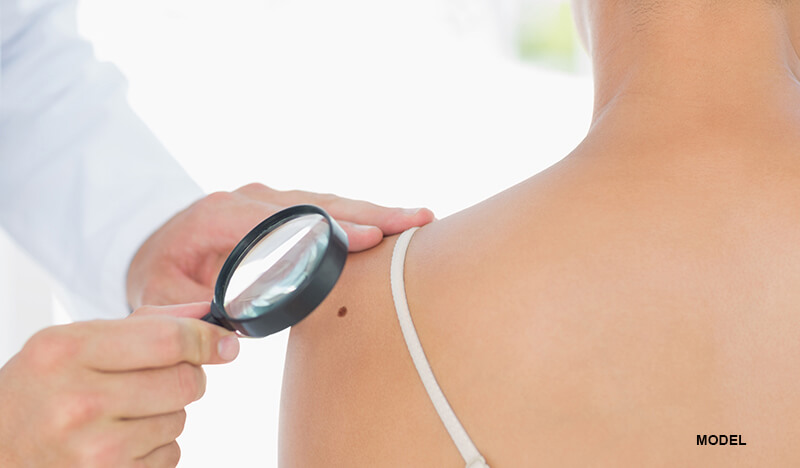Skin Tags vs. Moles: Key Differences, Concerns, and Removal Options

Skin tags and moles are two of the most common types of skin growths. Although both are generally harmless, people often confuse them due to their similar appearance. Understanding the differences between skin tags and moles is essential because, while skin tags are benign, some moles can develop into skin cancer. This guide will help you distinguish between them, recognize potential health concerns, and explore removal options.
What are moles?
Moles, also known as nevi, are pigmented skin growths that develop when melanocytes (pigment-producing cells) grow in clusters. They can appear anywhere on the body and may be present at birth or develop over time.
Types of moles:
- Congenital moles: Present at birth, these moles vary in size and are sometimes linked to an increased risk of melanoma.
- Acquired moles: These develop later in life, often due to sun exposure. Most are harmless, but some may become cancerous.
- Atypical (dysplastic) moles: These are irregularly shaped, larger than common moles, and can have varying colors. They may have a higher risk of turning into melanoma, especially if a person has many of them.
Causes of moles:
- Genetics: Some people are genetically predisposed to develop more moles.
- Sun exposure: UV radiation can increase mole development and lead to changes in existing moles, sometimes making them cancerous.
What are skin tags?
Skin tags, or acrochordons, are small, soft, flesh-colored growths that protrude from the skin. Unlike moles, they are not pigmented and do not contain clusters of melanocytes.
Common Causes:
- Friction: Often develop in areas where skin rubs against skin or clothing.
- Hormonal changes: More common during pregnancy or in people with hormonal imbalances, such as those with diabetes.
- Genetics: Some people are more prone to developing skin tags.
Where they appear:
- Neck
- Armpits
- Groin
- Eyelids
- Under the breasts
Who is more prone to skin tags?
- Overweight individuals due to increased skin friction.
- Pregnant women due to hormonal fluctuations.
- Individuals with diabetes or insulin resistance.
Why are moles and skin tags often confused for each other
While moles and skin tags are distinct, they share some similarities that can lead to confusion:
- Both can appear anywhere on the body.
- They may be small and skin-colored initially.
- Self-diagnosis can be difficult, especially when they occur in hard-to-see areas.
Differences Between Moles & Skin Tags
Moles:
- Size: Can be flat or raised, ranging from tiny to several centimeters wide.
- Color: Typically brown, black, or tan; may darken over time.
- Texture: Can be smooth or rough.
- Growth patterns: Some remain unchanged, while others may grow larger or change color over time.
Skin tags:
- Size: Usually small (a few millimeters to a centimeter), but can grow larger.
- Color: Flesh-toned or slightly darker.
- Texture: Soft and movable, often attached to the skin by a thin stalk.
- Growth patterns: Do not typically change in color or size once formed.
Should you be concerned about moles?
Most moles are harmless, but some can become cancerous. It is important to periodically monitor your moles and recognize warning signs by doing a monthly self-skin check and an annual skin examination by a board certified dermatologist.
The ABCDE Rule for identifying suspicious moles:
- A (Asymmetry): One half does not match the other.
- B (Border): Irregular, scalloped, or poorly defined edges.
- C (Color): Varying shades of brown, black, red, white, or blue.
- D (Diameter): Larger than 6mm (pencil eraser size).
- E (Evolving): Changes in size, shape, or color over time.
If a mole exhibits any of these characteristics, consult a dermatologist.
Should you be concerned about skin tags?
Skin tags are generally harmless, but they may become problematic if they:
- Are irritated by clothing or jewelry.
- Bleed frequently due to friction.
- Become painful or infected.
If any of these occur, a dermatologist can assess whether removal is necessary.
Preventing moles
- Sun protection: Regular use of sunscreen (SPF 30+) can help reduce new mole formation.
- Genetics: While some factors are unavoidable, monitoring, and early detection are key.
- Skincare habits: Avoid excessive sun exposure and use protective clothing.
Preventing skin tags
- Reduce friction: Wearing loose clothing can help minimize skin irritation.
- Maintain a healthy weight: Reducing excess weight may lower the risk of developing skin tags.
- Good skincare: Keeping skin clean and dry, especially in folds, may help prevent them.
When should moles be removed?
- Medical reasons: If a mole shows signs of cancerous changes.
- Cosmetic reasons: If the mole is in a visible area or causes self-consciousness.
- Irritation: If a mole is frequently rubbed by clothing or jewelry.
Common mole removal options
- Surgical excision: The mole is cut out, and the wound is stitched.
- Shave removal: The mole is shaved off the surface using a surgical blade.
- Laser removal: High-energy light destroys pigment cells.
- Cryotherapy: The mole is frozen off with liquid nitrogen.
When should skin tags be removed?
- Cosmetic reasons: If their appearance is bothersome.
- Irritation or infection: If a skin tag is painful or bleeding.
- Dermatologist consultation: If unsure whether the growth is a skin tag or another condition.
Common skin tag removal options
- Cryotherapy: Freezing the skin tag with liquid nitrogen.
- Cauterization: Burning the skin tag off using an electrical current.
- Snipping: Cutting the tag with sterilized scissors.
- Over-the-counter treatments: Solutions that dry out the tag until it falls off.
How a dermatologist can help
A dermatologist can:
- Properly diagnose whether a growth is a mole or a skin tag.
- Offer safe and effective removal techniques.
- Monitor skin changes over time to detect any potential health concerns.
Understanding the differences between skin tags and moles is crucial for both aesthetic and medical reasons. While skin tags are harmless and easily removed, moles require more careful monitoring, especially those that change in size, shape, or color. If you have concerns about a mole or skin tag, consulting a dermatologist is the best course of action to ensure your skin remains healthy.
Disclaimer: The contents of the Westlake Dermatology website, including text, graphics, and images, are for informational purposes only and are not intended to substitute for direct medical advice from your physician or other qualified professional.
